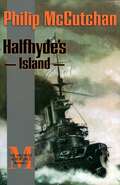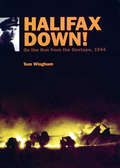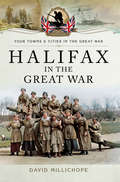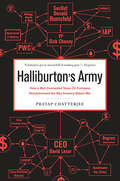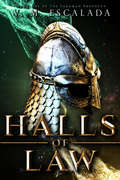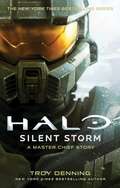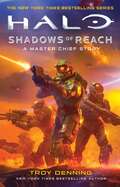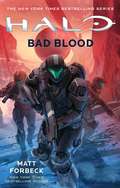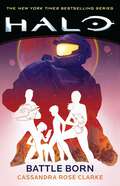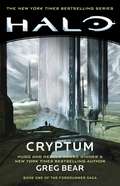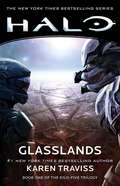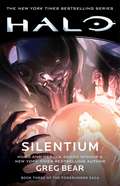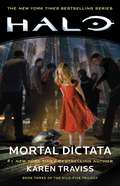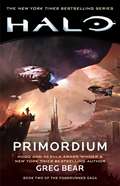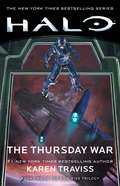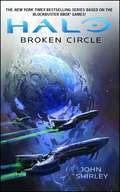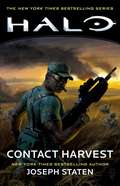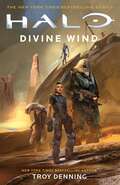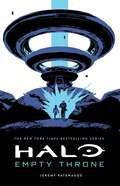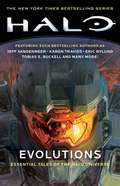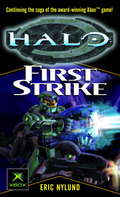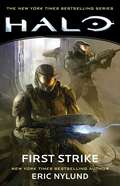- Table View
- List View
Halfhyde's Island
by Philip McCutchanRoyal Navy Lieutenant St. Vincent Halfhyde is assigned as second-in-command of the heavy cruiser Viceroy and ordered to a volcanic island that has recently surfaced in the north Pacific. The Admiralty hopes to claim the island for the Crown and establish an outpost there, but the hostile Russians have other ideas and the wily Japanese are prepared to carry out their own agenda.
Halifax Down!: On the Run from the Gestapo, 1944
by Tom WinghamA World War II aviator tells his story of evading the enemy in occupied territory after being shot down, and what happened to the rest of his crew. On the night of April 22, 1944, Tom Wingham was the bomb aimer in the crew of a 76 Squadron Halifax shot down while on the way to bomb Düsseldorf. Coming to in a tangle of parachute and harness straps, he realized the precariousness of his situation and so, dazed and aching with a painful concussion and navigating by the stars alone, he quickly set off on his long and difficult journey home through occupied territory, constantly depending on the kindness of others who risked their lives to help keep him hidden. He made his way from Holland, at the hands of &“The Escape&” and was then passed via &“L&’Armée Secrète,&” a London-run organization operating in the east of Belgium, but fell right into the path of the Gestapo. In a deadly game of hide and seek, he evaded his captors long enough to witness the retreat of German soldiers as he stayed at the house of Madame Schoofs, which became a temporary German HQ. In the 1980s, Tom Wingham assisted a Dutch air historian with some research and this prompted him to look into the details of his own crash. What he uncovered not only shed more light on his own story but also those of his fellow crew members. He plotted approximately where each person landed that fateful night—and slowly their incredible stories emerged.
Halifax in the Great War (Your Towns & Cities in the Great War)
by David MillichopeHalifax was surprised by the outbreak of war in August 1914 but within days the public mood had turned into a staggering display of unified support. Voluntary fund raising organisations sprang up and bore witness to an incredible self-help ethic that supported the troops at the front, their dependant families at home and the returning wounded. People came to fear the Zeppelins, were forced to retrieve their children from German naval guns in Scarborough and read with horror the stories of local lads gassed at the front. Residents of German descent found themselves in difficult situations, and Belgian refugees were offered sanctuary.Struggling local industry was revitalised by government orders for Khaki cloth, machine tools and munitions. Halifax can claim to have contributed many interesting technological items such as bomb release mechanisms, flame projectors and Tommy's iconic bowl shaped steel helmet. Women were increasingly employed in traditional male occupations. In 1917 the food crisis fermented tensions, but at the end of 1918 there was triumph of a sort.
Halliburton's Army: How a Well-connected Texas Oil Company Revolutionized the Way America Makes War
by Pratap ChatterjeeHalliburton's Army is the first book to show, in shocking detail, how Halliburton really does business, in Iraq, and around the world. From its vital role as the logistical backbone of the U. S. occupation in Iraq--without Halliburton there could be no war or occupation--to its role in covering up gang-rape amongst its personnel in Baghdad, Halliburton's Army is a devastating bestiary of corporate malfeasance and political cronyism. Pratap Chatterjee--one of the world's leading authorities on corporate crime, fraud, and corruption--shows how Halliburton won and then lost its contracts in Iraq, what Dick Cheney and Donald Rumsfeld did for it, and who the company paid off in the U. S. Congress. He brings us inside the Pentagon meetings, where Cheney and Rumsfeld made the decision to send Halliburton to Iraq--as well as many other hot-spots, including Somalia, Yugoslavia, Uzbekistan, Afghanistan, Guantánamo Bay, and, most recently, New Orleans. He travels to Dubai, where Halliburton has recently moved its headquarters, and exposes the company's freewheeling ways: executives leading the high life, bribes, graft, skimming, offshore subsidiaries, and the whole arsenal of fraud. Finally, Chatterjee reveals the human costs of the privatization of American military affairs, which is sustained almost entirely by low-paid unskilled Third World workers who work in incredibly dangerous conditions without any labor protection. Halliburton's Army is a hair-raising exposé of one of the world's most lethal corporations, essential reading for anyone concerned about the nexus of private companies, government, and war.
Halls of Law (Faraman Prophecy #1)
by V. M. EscaladaThe thrilling debut novel of “a fresh, engaging new fantasy series set in a world of marvelous texture and magic!” —Julie E. Czerneda, author of A Turn of LightLong ago, the first Luqs created the Faraman Polity—a stable, civilized empire now ruled by the descendants of the Luqs and held together by the combined powers of martial prowess and the Talents of the Halls of Law. For those who possess the magical Talent can see the truth of things, read people simply by touch, and and learn from any object the truth about everyone who has ever touched it.That is not a power young Kerida Nast has ever wanted, for her greatest desire is to join the military ranks. So, when her psychic Talents are discovered, the dejected Ker is placed under the strict tutelage of the Hall, where she knows she must forsake her family and friends forever.But her education is short-lived.For the shadowy Halia launch an invasion of the Polity, razing the Halls to the ground and systematically slaughtering every Talent they can find. Ker barely escapes the carnage along with Tel Cursar—a young soldier who witnessed the deaths of the royal family. And without the unifying force of the Luqs bloodline, everything the Polity represented will fall to ruin and the Rule of Law will die.Now, Ker must somehow find an heir to the throne before the Halia wipe out the Luqs forever, and somehow manage to keep herself alive. Her search will take her far from home and into the depths of the land itself—where she will find an ally from the most unlikely of places…From legend.
Halo: A Master Chief Story (Halo #24)
by Troy DenningA Master Chief story and original full-length novel set in the Halo universe—based on the New York Times bestselling video game series!2526. It has been a year since humanity engaged in its destructive first contact with a theocratic military alliance of alien races known as the Covenant. Now the hostilities have led to open war, and the United Nations Space Command understands virtually nothing about its new enemy. There are only two certainties—the Covenant is determined to eradicate humanity, and they have the superior technology to do just that. The UNSC&’s only hope lies with the Spartans: enhanced supersoldiers raised and trained from childhood via a clandestine black ops project to be living weapons. Their designated commander, Petty Officer John-117, has been assigned to lead the Spartans on a desperate counterattack designed to rock the Covenant back on its heels, and to buy humanity the time it needs to gather intelligence and prepare its defenses. But not everyone wants the Spartans to succeed. A coalition of human insurrectionist leaders believes an alliance with the Covenant to be its best hope of finally winning independence from the Unified Earth Government. To further their plans, the insurrectionists have dispatched a sleeper agent to sabotage the UNSC counterattack—and ensure that John-117 and the Spartans never return from battle....
Halo: A Master Chief Story (Halo #26)
by Troy DenningA Master Chief story and original full-length novel set in the Halo universe—based on the New York Times bestselling video game series!2526. It has been more than a year since humanity first encountered the hostile military alliance of alien races known as the Covenant, and several weeks after the United Nations Space Command&’s devastating counterattack of Operation: SILENT STORM was deemed an overwhelming success. The UNSC has put its faith in the hands of the Spartans, led by the legendary Master Chief, John-117: enhanced super-soldiers raised and trained from childhood via a clandestine black ops project to be living weapons. But the Covenant—enraged and fearful of their enemy&’s unexpected strategies and prowess—is not taking its recent defeat lightly, and is now fully determined to eradicate humanity from existence, brutally overrunning the ill-fated planets of the Outer Colonies faster than retreats can be ordered. If the UNSC has any chance of stemming the tide of the war, the Master Chief and Blue Team must drop onto an empty, hellish world in order to capture a disabled Covenant frigate filled with valuable technology. It has all the makings of a trap, but the bait is far too tempting to ignore—and this tantalizing prize is being offered by a disgraced and vengeful Covenant fleetmaster, whose sole opportunity for redemption lies in extinguishing humanity&’s only hope of survival…
Halo: A Master Chief Story (Halo #27)
by Troy DenningUSA TODAY BESTSELLER A Master Chief story and original full-length novel set in the Halo universe—based on the New York Times bestselling video game series!October 2559. It has been a year since the renegade artificial intelligence Cortana issued a galaxy-wide ultimatum, subjecting many worlds to martial law under the indomitable grip of her Forerunner weapons. Outside her view, the members of Blue Team—John-117, the Master Chief; Fred-104; Kelly-087; and Linda-058—are assigned from the UNSC Infinity to make a covert insertion onto the ravaged planet Reach. Their former home and training ground—and the site of humanity&’s most cataclysmic military defeat near the end of the Covenant War—Reach still hides myriad secrets after all these years. Blue Team&’s mission is to penetrate the rubble-filled depths of CASTLE Base and recover top-secret assets locked away in Dr. Catherine Halsey&’s abandoned laboratory—assets which may prove to be humanity&’s last hope against Cortana. But Reach has been invaded by a powerful and ruthless alien faction, who have their own reasons for being there. Establishing themselves as a vicious occupying force on the devastated planet, this enemy will soon transform Blue Team&’s simple retrieval operation into a full-blown crisis. And with the fate of the galaxy hanging in the balance, mission failure is not an option…
Halo: Bad Blood (Halo #23)
by Matt ForbeckAn original full-length novel set in the Halo universe and based on the New York Times bestselling video game series!Just hours following their climactic battle on the Forerunner planet Genesis, the Spartans of Blue Team and Fireteam Osiris find themselves running for their lives from the malevolent machinations of the now-renegade artificial intelligence Cortana. But even as they attempt to stay one step ahead, trouble seems to find Spartan Edward Buck no matter where he turns. A secret mission enacted by the Office of Naval Intelligence could possibly help turn the tide, and has Buck reluctantly agreeing to reform his old team, Alpha-Nine. Because if the band is really getting back together for this one, that means everybody—including the Spartan who Buck never wants to see again, the one who committed the ultimate betrayal of trust…
Halo: Battle Born (Halo #2)
by Cassandra Rose ClarkeDiscover the original novel set in the Halo universe, based on the New York Times bestselling video game series!Saskia, Dorian, Evie, and Victor aren&’t exactly friends at their small high school on the middle-of-nowhere colony world of Meridian. Each has their own problems, from absent parents to supporting their family, getting into a good college to making the next hit holo-film. But those problems were nothing next to the threat now facing their world: The alien alliance known as the Covenant is laying siege to Meridian, for reasons that aren&’t so easily explained. With their village in flames, the four teens find themselves stuck above ground, locked out of the town shelter where the rest of the survivors are gathered. Together, Saskia, Dorian, Evie, and Victor are thrust into battle with nothing but a few scavenged weapons and an injured Spartan, one of the UNSC&’s super-soldiers. What&’s forged from the destruction will determine the fate of Meridian and tilt the battle for humanity&’s survival.
Halo: Book One of the Forerunner Saga (Halo #8)
by Greg BearThe first novel in the Forerunner Saga trilogy by science fiction legend Greg Bear—set in the Halo universe and based on the New York Times bestselling video game series!One hundred thousand years ago, the galaxy was populated by a great variety of beings. But one species—eons beyond all others in both technology and knowledge—achieved dominance. They ruled in peace, but met opposition with quick and brutal effectiveness. They were the Forerunners—the keepers of the Mantle of Responsibility, the next stage of life in the Universe&’s Living Time. And then they vanished. This is their story.
Halo: Book One of the Kilo-Five Trilogy (Halo #11)
by Karen TravissThe first novel of the Kilo-Five Trilogy by #1 New York Times bestselling author Karen Traviss—part of the expanded universe based on the award-winning video game series Halo!2553. The theocratic military alliance known as the Covenant has collapsed after a long, brutal war with humanity that saw billions slaughtered on Earth and its colonies. For the first time in thirty years, however, peace finally seems possible. But though the fighting has stopped, the war is far from over: it&’s just gone underground. The United Nations Space Command&’s feared and secretive Office of Naval Intelligence recruits Kilo-Five—a clandestine team of Orbital Drop Shock Troopers, a Spartan super-soldier, and a diabolical AI—to accelerate the insurrection within the Covenant&’s warrior species, the Sangheili, even as their notable defector-turned-leader Thel &‘Vadam—the Arbiter—struggles to stave off civil war among his divided people. Across the galaxy, a woman thought to have died in the Covenant attack on the planet Reach is actually very much alive. Chief scientist Dr. Catherine Halsey broke every law in the book to create the Spartan program, and now she&’s broken some more rules to save them. Marooned with Senior Chief Petty Officer Franklin Mendez and a Spartan team in a Forerunner slipspace bubble hidden in the destroyed planet Onyx, Halsey finds that this place has been guarding an ancient secret—a treasure trove of Forerunner technology that will change everything for the UNSC and mankind. As Kilo-Five joins the hunt for Halsey, humanity&’s violent past begins to catch up with all of them as the disgruntled colony Venezia has been biding its time to strike at Earth…and its most dangerous terrorist has an old, painful link with both Halsey and Kilo-Five that will test everyone&’s loyalty to the limit.
Halo: Book Three of the Forerunner Saga (Halo #10)
by Greg BearThe final novel of the Forerunner Saga trilogy by science fiction legend Greg Bear—set in the Halo universe and based on the New York Times bestselling video game series!One hundred thousand years ago. Chaos rules the final days of the Forerunner empire. The Flood—a horrifying, shape-changing, and unstoppable parasite—has arrived in force, aided by unexpected allies, and internal strife has desperately weakened Forerunner defenses. Facing the imminent collapse of their civilization, the Forerunners known as the Ur-Didact and the Librarian reveal what they know about the relationship between the long-vanished race of the Precursors and the Flood. While the Precursors created many technological species, including those of the Forerunners and humanity itself, the roots of the Flood may be found in an act of enormous barbarity, carried out beyond our galaxy ten million years before. Because of that savagery, a greater evil looms. Only the Ur-Didact and the Librarian—husband and wife pushed into desperate conflict—hold the keys to a solution. As they face the consequences of a mythic tragedy, one of them must now commit the greatest atrocity of all time—a shocking act designed to prevent an insane abomination from dominating the entire galaxy…
Halo: Book Three of the Kilo-Five Trilogy (Halo #13)
by Karen TravissThe final novel of the Kilo-Five Trilogy by #1 New York Times bestselling author Karen Traviss—part of the expanded universe based on the award-winning video game series Halo!2553. With the thirty-year-long Covenant War finally over, the Office of Naval Intelligence faces old grievances rising again to threaten Earth. Angry and bitter colonists—still wanting to settle scores from an insurrection put on hold for three decades—crave justice…as does a man whose life was torn apart by ONI when his young daughter was abducted for the SPARTAN-II program. Black-ops squad Kilo-Five now find its collective loyalty tested beyond the breaking point when the father of their Spartan comrade, still searching for the truth about her disappearance, prepares to glass Earth&’s cities to get an answer. How far will Kilo-Five go to stop him? And will he be able to live with the truth when he finds it? The painful answer lies with someone long dead, and a conscience that still survives in the most unlikely, undiscovered place…
Halo: Book Two of the Forerunner Saga (Halo #9)
by Greg BearThe second novel of the Forerunner Saga trilogy by science fiction legend Greg Bear—set in the Halo universe and based on the New York Times bestselling video game series!One hundred thousand years ago. In the wake of the apparent self-destruction of the alien Forerunner empire, two humans—Chakas and Riser—are like flotsam washed up on very strange shores indeed. Captured by the Forerunner known as the Master Builder and then misplaced during a furious battle in space, Chakas and Riser now find themselves on an inverted world, where horizons rise into the sky and humans of all kinds are trapped in a perilous cycle of horror and neglect. They have become both research animals and strategic pawns in a cosmic game whose madness knows no end—a game of ancient vengeance between the powers who seeded the galaxy with life, and the Forerunners who expect to inherit their sacred Mantle of Responsibility to all living things. In the company of a young girl and an old man, Chakas begins an epic journey across a lost and damaged Halo ringworld in search of a way home, an explanation for the warrior spirits rising up within, and the reason for the Forerunner Librarian&’s tampering with human destiny. Their travels will take them into the domain of a powerful and monstrous intelligence—known as &“the Captive&” by Forerunners, and &“the Primordial&” by ancient human warriors, this being may not only control the fate of Chakas, Riser, and the rest of humanity, but of all sentient life across the galaxy…
Halo: Book Two of the Kilo-Five Trilogy (Halo #12)
by Karen TravissThe second novel of the Kilo-Five Trilogy by #1 New York Times bestselling author Karen Traviss—part of the expanded universe based on the award-winning video game series Halo!2553. Welcome to humanity&’s new war: silent, high stakes, and unseen. This is a life-or-death mission for the Office of Naval Intelligence&’s black-ops team, Kilo-Five, which is tasked with preventing the ruthless Sangheili, once the military leaders of the alien alliance known as the Covenant, from regrouping and threatening humankind again. What began as a routine dirty-tricks operation—keeping the Sangheili occupied with their own insurrection—turns into a desperate bid to extract one member of Kilo-Five from the seething heart of a brutal civil war. But troubles never come singly for Kilo-Five. Colonial terrorism is once again surfacing on one of the human worlds that survived the war against the Covenant, and the man behind it is much more than just a name to Spartan Naomi-010. Meanwhile, the treasure trove of Forerunner technology recovered from the Forerunner shield world of Onyx is being put to work, even as a kidnapped Sangheili plots vengeance on the humans he fears will bring his people to the brink of destruction…
Halo: Broken Circle (Halo #14)
by John ShirleyThe New York Times bestselling series based on the blockbuster Xbox® games!Centuries before the Human-Covenant War would rage across the galaxy, a similar conflict erupted between the Prophets and the Elites—two alien races at odds over the sacred artifacts left by the powerful Forerunners, who disappeared eons ago. Although they would eventually form a stable alliance called the Covenant, there are those on both sides who question this fateful union. From an Elite splinter group rebelling against the Covenant during the time of its founding...to a brave Prophet caught in the machinations of the new leadership...to the root of the betrayal that would ultimately shatter the Covenant many years later, this is the untold chapter of the most unexpected heroes emerging from a realm filled with shocking treachery and ceaseless wonder.Copyright © 2014 by Microsoft Corporation. All Rights Reserved. Microsoft, Halo, the Halo logo, Xbox, and the Xbox logo are trademarks of the Microsoft group of companies.
Halo: Contact Harvest (Halo #5)
by Joseph StatenThe New York Times bestseller—part of the expanded universe based on the award-winning video game series Halo!2524. Harvest is a peaceful, prosperous farming colony on the very edge of human-controlled space. But humanity has unknowingly trespassed on holy ground—straying into the path of the aggressive, theocratic empire known as the Covenant. What begins as a chance encounter between an alien privateer and a human freighter soon catapults all of mankind into a struggle for its very existence. But humanity is also currently locked in a bitter civil war of its own: the Insurrection. With resources strained to the breaking point, the ultimate survival of Harvest&’s citizens falls to a squad of battle-weary UNSC Marines and their inexperienced colonial militia trainees. In this unlikely group of heroes, one will stand above the rest—a young Marine staff sergeant named Avery Johnson....
Halo: Divine Wind (Halo #29)
by Troy DenningAn original novel set in the Halo universe—based on the New York Times bestselling video game series! October 2559. With the galaxy in the suffocating grip of a renegade artificial intelligence, another perilous threat has quietly emerged in the shadows: the Keepers of the One Freedom, a fanatical and merciless Covenant splinter group, has made its way beyond the borders of the galaxy to an ancient Forerunner installation known as the Ark. Led by an infamous Brute named Castor, the Keepers intend to achieve what the Covenant, in all its might, failed to: activate Halo and take the last steps on the path of the Great Journey into transcendence. But unknown to Castor and his new, unexpected ally on the Ark, there are traitors to the cause in their midst—namely the Ferrets, composed of Office of Naval Intelligence operative Veta Lopis and her young team of Spartan-IIIs, who have been infiltrating the Keepers to lay the groundwork for Castor&’s assassination. But with ONI&’s field operations now splintered and cut off by the Guardian threat, Veta&’s original mission has suddenly and dramatically escalated in scope. There&’s simply no choice or fallback plan—either the Ferrets somehow stop the Keepers or the galaxy faces an extinction-level event….
Halo: Empty Throne (Halo #33)
by Jeremy PatenaudeAn original novel set in the Halo universe—based on the New York Times bestselling video game series!2559. It has been a year since the rogue artificial intelligence Cortana seized control of the Domain, an otherworldly dimension housing a vast information network. With an array of Forerunner weapons at her disposal, Cortana set out to enforce an authoritarian peace on the civilizations of the galaxy. But as the United Nations Space Command flagship Infinity prepares to strike against Cortana at Zeta Halo, another plan has also been set in motion. An ancient access point hidden on a seemingly insignificant human colony has become the focus of a parallel effort to claim the Domain and its immeasurable capabilities. The UNSC, however, needs a key: a living, forsaken product of an old war. As a new generation of heroes rise to meet this challenge, and Cortana's pursuit of control reaches a desperate and sudden crescendo, a cunning, ruthless warrior emerges from the shadows of the Banished, who has vowed to fill the new power vacuum by any means necessary…
Halo: Envoy (Halo #20)
by Tobias S. BuckellAn original full-length novel set in the Halo universe and based on the New York Times bestselling video game series!It has been six years since the end of the Covenant War...and yet on the planet Carrow, a world on the edge of the Joint Occupation Zone, a decisive new battle suddenly erupts. Human colonists and the alien Sangheili have already been living a tension-filled coexistence in this place, with Unified Earth Government envoy Melody Azikiwe attempting to broker a lasting peace between their two species. But as civil war now engulfs the Sangheili, Melody must act on an additional covert assignment courtesy of the Office of Naval Intelligence: free the SPARTAN-IIs known as Gray Team, held in stasis since the end of the war by a cunning Elite fleetmaster consumed with vengeance. And none can anticipate the ongoing violence leading to the discovery of an even greater, unstoppable threat—one hidden for eons below the surface of the planet...
Halo: Epitaph (Halo #32)
by Kelly GayAn original novel set in the Halo universe—based on the New York Times bestselling video game series!Stripped of armor, might, and memory, the legendary Forerunner warrior known as the Didact was torn from the physical world following his destructive confrontation with the Master Chief and sent reeling into the mysterious depths of a seemingly endless desert wasteland. This once powerful and terrifying figure is now a shadow of his former self—gaunt, broken, desiccated, and alone. But this wasteland is not as barren as it seems. A blue light glints from a thin spire in the far distance… Thus begins the Didact&’s great journey—the final fate of one of the galaxy&’s most enigmatic and pivotal figures.
Halo: Essential Tales of the Halo Universe (Halo #7)
by VariousThe thrilling short story collection featuring Jeff VanderMeer, Karen Traviss, and Eric Nylund—part of the expanded universe based on the New York Times bestselling video game series Halo!When humanity expanded beyond the safety of Earth to new stars and horizons, it never dreamed what dangers would be encounter there. When the theocratic alien juggernaut known as the Covenant declared war upon the fragile human empire, millions of lives were lost—but millions of heroes also rose to the challenge. In such a far-reaching conflict, not many tales of the brave have a chance to become legend. This collection of eleven stories dives into the depths of the vast Halo universe, not only from the perspective of those who fought and died to save humanity, but also from those who vowed to wipe it out of existence.
Halo: First Strike
by Eric NylundThe Human-Covenant war rages on as the alien juggernaut sweeps inexorably toward its final goal: destruction of all human life!Halo has been destroyed, and the threat it posed to sentient life, neutralized. But victory has come at a terrible cost for the UNSC. Thousands of valiant soldiers fell in the battle to prevent the alien construct from falling into the enemy's clutches. Now, everything depends on the Spartan known as the "Master Chief." Yet even with the aid of the artificial intelligence Cortana, the Master Chief will be hard-pressed to rescue survivors and evade the Covenant ships patrolling the remains of Halo in debris-strewn space. Ahead lies a dangerous voyage home, through a gauntlet of Covenant forces. For the sake of all, the Master Chief and his war-torn squad must not only survive, but take the fight to the enemy with a decisive first strike.This novel is based on a Mature-rated video game.Bungie, Halo, Xbox, the Microsoft Game Studios logo and the Xbox Logos are registered trademarks or trademarks of Microsoft Corporation in the United States and/or other countries. Used under license. © 2003 Microsoft Corporation. All Rights Reserved. From the Paperback edition.
Halo: First Strike (Halo #3)
by Eric NylundThe New York Times bestselling aftermath of Halo: Combat Evolved featuring the Master Chief—part of the expanded universe based on the award-winning video game series!2552. The theocratic military alliance known as the Covenant is showing no mercy as it continues to assault every human world it encounters, but in the way lies humanity&’s greatest champion, the super-soldier Spartan John-117—the Master Chief. Together with his AI companion Cortana and the last remaining Spartans, the galaxy-spanning fight rages on two fronts following the destruction of the human military stronghold Reach by Covenant forces and the mysterious artificial ringworld known as &“Halo&” at the hands of the Master Chief. One faction—a squad of Spartans lead by Blue Team&’s Fred-104 and Kelly-087—is trapped on the glassed surface of Reach, the only planet they&’ve ever known as home. And beneath this ruined world, Dr. Catherine Halsey has discovered an ancient secret...one that could alter the course of the war. Meanwhile, the Master Chief and Cortana lead a second group toward a gathering of Covenant warships, as the United Nations Space Command&’s worst nightmare has finally come true: the Covenant has discovered the location of Earth and is forming a massive fleet to utterly destroy it, as well as all who oppose the indomitable will of the Prophets…
